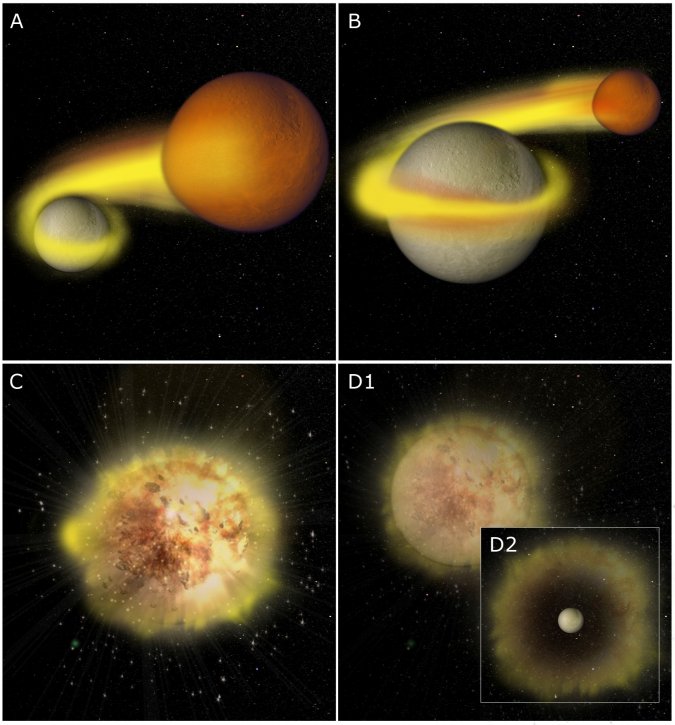Not all explosions are created equal: It’s as true for film effects as it is for the stars. Yet, until now, scientists had only observed two basic kinds of exploding stars, known as supernovae. Now, scientists at the Weizmann Institute of Science, in collaboration with others around the world, have identified a third type of supernova. Their findings appeared this week in Nature.
The first two types of supernova are either hot, young giants that go out in a violent display as they collapse under their own weight, or old, dense, white dwarves that blow up in a thermonuclear explosion. The new supernova appeared in telescope images in early January 2005, and scientists, seeing that it had recently begun the process of exploding, started collecting and combining data from different telescope sites around the world, measuring both the amount of material thrown off in the explosion and its chemical makeup. But Dr. Avishay Gal-Yam, Hagai Perets (now at the Harvard-Smithsonian Center for Astrophysics), Iair Arcavi, and Michael Kiewe of the Weizmann Institute’s Faculty of Physics, together with Paolo Mazzali of the Max-Planck Institute for Astrophysics, Germany, the Scuola Normale Superiore, Pisa, and INAF/Padova Observatory in Italy, Prof. David Arnett from the University of Arizona, and researchers from across the US, Canada, Chile, and the UK, soon found that the new supernova did not fit either of the known patterns.
On the one hand, the amount of material hurled out from the supernova was too small for it to have come from an exploding giant. In addition, its location, distant from the busy hubs where new stars form, implied that it was an older star that had had time to wander off from its birthplace. On the other hand, its chemical makeup didn’t match that commonly seen in the second type. “It was clear,” says Dr. Perets, the paper’s lead author, “that we were seeing a new type of supernova.” The scientists turned to computer simulations to see what kind of process could have produced such a result.
The common type of exploding white dwarf (a type Ia supernova) is mainly made up of carbon and oxygen, and the chemical composition of the ejected material reflects this. The newly discovered supernova had unusually high levels of the elements calcium and titanium; these are the products of a nuclear reaction involving helium, rather than carbon and oxygen. “We’ve never before seen a spectrum like this one,” says Dr. Mazzali. “It was clear that the unique chemical composition of this explosion held an important key to understanding it.” Where did the helium come from? The simulations suggest that a pair of white dwarves are involved; one of them stealing helium from the other. When the thief star’s helium load rises past a certain point, the explosion occurs. “The donor star is probably completely destroyed in the process, but we’re not quite sure about the fate of the thief star,” says Dr. Gal-Yam.
The scientists believe that several other previously observed supernovae may fit this pattern. In fact, these relatively dim explosions might not be all that rare; if so, their occurrence could explain some puzzling phenomena in the universe. For example, almost all the elements heavier than hydrogen and helium have been created in, and dispersed by, supernovae; the new type could help explain the prevalence of calcium in both the universe and in our bodies. It might also account for observed concentrations of particles called positrons in the center of our galaxy. Positrons are identical to electrons, but with an opposite charge, and some have hypothesized that the decay of yet unseen “dark matter” particles may be responsible for their presence. But one of the products of the new supernova is a radioactive form of titanium that, as it decays, emits positrons. “Dark matter may or may not exist,” says Dr. Gal-Yam, “but these positrons are perhaps just as easily accounted for by the third type of supernova.”

A new type of explosion may explain the course of calcium. How does it work? Above is an illustration of a close-up view.
The exploding system is composed of two compact white dwarf stars—the dying embers left from the cores of stars similar to the sun. The more massive of the two (whose physical size is actually larger, a peculiar property of these objects), seen on the left side of panel A, is stealing mass from its less massive, but larger, companion, seen on the right. This mass is mostly helium gas.
Zooming closer to the mass thief (panel B), we can see that the helium mass streaming from the companion accumulates onto the surface of the heavier star, and is compressed by its huge gravitational force. The lighter star gradually loses most of its mass, and may eventually be totally destroyed by its gregarious neighbor.
When the mass of helium accumulated on the mass thief becomes very hot and dense, a nuclear explosion occurs (panel C). The helium explodes and is transformed into elements such as calcium and titanium, eventually producing the building blocks of life for future generations of stars.
The fate of the mass thief is unclear. It is known that the bulk of its mass does not undergo nuclear explosion. This tough star may actually survive the explosion (panel D1), or else the explosion may trigger its compression and collapse into an object even more dense and compact—a neutron star, no larger than the size of a big city on earth (shown, not to scale, in panel D2). Resolving the ultimate fate of this star remains a mystery for future studies.
Image credits: Dr. Avishay Gal-Yam, Weizmann Institute of Science. (This image accompanies a paper by Perets et al. in Nature, May 20, 2010.)
Dr. Avishay Gal-Yam's research is supported by the Nella and Leon Benoziyo Center for Astrophysics; the Yeda-Sela Center for Basic Research; the Peter and Patricia Gruber Awards; the Legacy Heritage Fund Program of the Israel Science Foundation; and Miel de Botton Aynsley ,UK.
